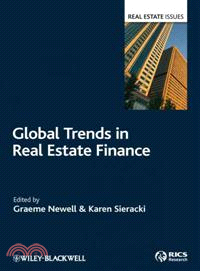Global Trends In Real Estate Finance
商品資訊
ISBN13:9781405151283
出版社:John Wiley & Sons Inc
作者:Newell
出版日:2009/12/04
裝訂/頁數:精裝/312頁
定價
:NT$ 5622 元優惠價
:90 折 5060 元
若需訂購本書,請電洽客服 02-25006600[分機130、131]。
商品簡介
作者簡介
目次
相關商品
商品簡介
To operate effectively in today’s dynamic global real estate markets, it is essential to understand the complex processes that underpin them. This up-to-date work, which brings together contributions from industry and academic experts from around the world, is a valuable corollary to effective investment decision-making within the property sector and will be of interest to post-graduate property students, researchers and practising real estate investors.
Recent years have seen some rapid developments in the global scale and structure of real estate markets. Such transformations have been paralleled by significant changes in the financial structures, and processes that serve these markets, including sophisticated new investment and finance structures and products. Examples of these include the real estate investment trusts (REIT) products that have been developed in USA, Europe and Asia, the range of unlisted products emerging in UK and Europe, and the innovative financing structures being developed in many countries.
Global Trends in Real Estate Finance addresses this emerging complexity and sophistication in contemporary real estate markets by discussing the history, merits and implications of a range of products and processes. Also examined are the changes in the practices and environment needed to ensure the success of these property products, including increased disclosure, corporate governance, market transparency and improved skills base.
Chapters are written by leading international contributors, both academic and practitioner. The context is explicitly international, with a focus on UK, Europe, Asia, Australia and the USA. The aim is to identify specific market areas to describe the key innovations, rather than simply providing a description of various geographical markets.
Recent years have seen some rapid developments in the global scale and structure of real estate markets. Such transformations have been paralleled by significant changes in the financial structures, and processes that serve these markets, including sophisticated new investment and finance structures and products. Examples of these include the real estate investment trusts (REIT) products that have been developed in USA, Europe and Asia, the range of unlisted products emerging in UK and Europe, and the innovative financing structures being developed in many countries.
Global Trends in Real Estate Finance addresses this emerging complexity and sophistication in contemporary real estate markets by discussing the history, merits and implications of a range of products and processes. Also examined are the changes in the practices and environment needed to ensure the success of these property products, including increased disclosure, corporate governance, market transparency and improved skills base.
Chapters are written by leading international contributors, both academic and practitioner. The context is explicitly international, with a focus on UK, Europe, Asia, Australia and the USA. The aim is to identify specific market areas to describe the key innovations, rather than simply providing a description of various geographical markets.
作者簡介
Graeme Newell, Professor of Property Investment, School of Construction ,Property and Planning, University of Western Sydney
Karen Sieracki, director of KASPAR Associates Ltd - property research
Karen Sieracki, director of KASPAR Associates Ltd - property research
目次
Preface
Contributors
Part I: Products
1. Global REITs universe continues to expand and develop (Lijian Chen and Thomas I. Mills).
Global core real estate universe: $8 trillion and growing
Why have REITs succeeded?
REIT proliferation: thriving in 18 countries and counting
Early growth cycle: only the tip of the iceberg
Relative risk and return
2. The US real estate investment trust (REIT) market (Will McIntosh).
Introduction
The evolution of US REITs
US REITs: creation to 1993
US REITs: the Modern Era
The investment performance of REITs
The future of REITs
3. Progress on REIT regimes in Europe (Simon Clark and Tom Road, Linklaters, Olivier Mesmin, Baker McKenzie, Matthias Roche).
Introduction
Developments in France: SIIC 2/3/4 and the OPCI
OPCI: ‘the non-listed SIIC’
The German REIT
The UK REIT
EU law and REITs: what are the issues?
4. Listed Property Trusts in Australia (Graeme Newell).
Background to LPTs
LPT regulatory framework
LPT profile
LPT performance analysis
Recent issues in the strategic development of LPTs
Changing LPT and property landscape in 2007–2008
Conclusion
5. Asian REITs: playing the yield game (Joseph T.L. Ooi and Neo Poh Har).
REIT markets in Asia
Ways to enhance distribution yield
Yield-accretive acquisitions
Conclusion
6. European real estate unlisted vehicles: a mature market now or is there more to come? (Karen Sieracki).
Introduction
Characteristics of European real estate unlisted vehicles
Performance of European real estate unlisted vehicles
Management fees
Discussion and conclusion
7. Constructing a Global Real Estate Investment Index (Ian Cullen).
Introduction
Top down or bottom up?
Rolling out national market indices
The first IPD multi-market index – the pan-European
…and finally the world – IPD’s first global index
8. Property derivatives (Gary McNamara).
Introduction
The history and innovation behind the property derivatives market
The drivers for change
Pricing and underlying index activity
Alternative indices and products being traded
Has the market achieved the results expected of it?
How have derivatives changed the market place?
Future expectations, unintended consequences and lessons learned
Conclusions
9. Property markets in central and eastern Europe (Stanley McGreal, Jim Berry and Alastair Adair).
Introduction
Development of real estate markets
Property markets, data availability and economic competitiveness
Bank lending on property in central and eastern Europe
Conclusions
10. Islamic finance and Shariah compliant real estate investment (Ali Parsa, University of Ulster, and Ali Muwlazadeh).
Introduction
Defining SCI
Shariah funds in the research agenda
Conclusion
PART II: Processes
11. Socially responsible property investment – background, trends and consequences (Thomas Lutzkendorf and David Lorenz).
Introduction
Social responsibility and sustainable development – background
The principles for responsible investment
Trends and concepts within the property market
The benefits of sustainable buildings and of SRIs
Criteria and assessment tools
Realisation of SRPIs
Implications for property professionals
Conclusion and recommendations
12. Corporate governance in the real estate industry (Prof. Dr. Karl-Werner Schulte, Prof. Dr. Wolfgang Schäfers and Nicolas Kohl).
Introduction
Reasons for the rising importance of corporate governance
Existing corporate governance principles for the real estate industry
Impact of corporate governance on firm value
Research agenda for corporate governance in the real estate industry
Appendices
13.The future of real estate education (Tony Key).
Introduction
The demand for real estate skills
Paradigms for real estate education
A real estate body of knowledge
The methods of real estate education
The future of real estate education
Index.
Contributors
Part I: Products
1. Global REITs universe continues to expand and develop (Lijian Chen and Thomas I. Mills).
Global core real estate universe: $8 trillion and growing
Why have REITs succeeded?
REIT proliferation: thriving in 18 countries and counting
Early growth cycle: only the tip of the iceberg
Relative risk and return
2. The US real estate investment trust (REIT) market (Will McIntosh).
Introduction
The evolution of US REITs
US REITs: creation to 1993
US REITs: the Modern Era
The investment performance of REITs
The future of REITs
3. Progress on REIT regimes in Europe (Simon Clark and Tom Road, Linklaters, Olivier Mesmin, Baker McKenzie, Matthias Roche).
Introduction
Developments in France: SIIC 2/3/4 and the OPCI
OPCI: ‘the non-listed SIIC’
The German REIT
The UK REIT
EU law and REITs: what are the issues?
4. Listed Property Trusts in Australia (Graeme Newell).
Background to LPTs
LPT regulatory framework
LPT profile
LPT performance analysis
Recent issues in the strategic development of LPTs
Changing LPT and property landscape in 2007–2008
Conclusion
5. Asian REITs: playing the yield game (Joseph T.L. Ooi and Neo Poh Har).
REIT markets in Asia
Ways to enhance distribution yield
Yield-accretive acquisitions
Conclusion
6. European real estate unlisted vehicles: a mature market now or is there more to come? (Karen Sieracki).
Introduction
Characteristics of European real estate unlisted vehicles
Performance of European real estate unlisted vehicles
Management fees
Discussion and conclusion
7. Constructing a Global Real Estate Investment Index (Ian Cullen).
Introduction
Top down or bottom up?
Rolling out national market indices
The first IPD multi-market index – the pan-European
…and finally the world – IPD’s first global index
8. Property derivatives (Gary McNamara).
Introduction
The history and innovation behind the property derivatives market
The drivers for change
Pricing and underlying index activity
Alternative indices and products being traded
Has the market achieved the results expected of it?
How have derivatives changed the market place?
Future expectations, unintended consequences and lessons learned
Conclusions
9. Property markets in central and eastern Europe (Stanley McGreal, Jim Berry and Alastair Adair).
Introduction
Development of real estate markets
Property markets, data availability and economic competitiveness
Bank lending on property in central and eastern Europe
Conclusions
10. Islamic finance and Shariah compliant real estate investment (Ali Parsa, University of Ulster, and Ali Muwlazadeh).
Introduction
Defining SCI
Shariah funds in the research agenda
Conclusion
PART II: Processes
11. Socially responsible property investment – background, trends and consequences (Thomas Lutzkendorf and David Lorenz).
Introduction
Social responsibility and sustainable development – background
The principles for responsible investment
Trends and concepts within the property market
The benefits of sustainable buildings and of SRIs
Criteria and assessment tools
Realisation of SRPIs
Implications for property professionals
Conclusion and recommendations
12. Corporate governance in the real estate industry (Prof. Dr. Karl-Werner Schulte, Prof. Dr. Wolfgang Schäfers and Nicolas Kohl).
Introduction
Reasons for the rising importance of corporate governance
Existing corporate governance principles for the real estate industry
Impact of corporate governance on firm value
Research agenda for corporate governance in the real estate industry
Appendices
13.The future of real estate education (Tony Key).
Introduction
The demand for real estate skills
Paradigms for real estate education
A real estate body of knowledge
The methods of real estate education
The future of real estate education
Index.
主題書展
更多
主題書展
更多書展今日66折
您曾經瀏覽過的商品
購物須知
外文書商品之書封,為出版社提供之樣本。實際出貨商品,以出版社所提供之現有版本為主。部份書籍,因出版社供應狀況特殊,匯率將依實際狀況做調整。
無庫存之商品,在您完成訂單程序之後,將以空運的方式為你下單調貨。為了縮短等待的時間,建議您將外文書與其他商品分開下單,以獲得最快的取貨速度,平均調貨時間為1~2個月。
為了保護您的權益,「三民網路書店」提供會員七日商品鑑賞期(收到商品為起始日)。
若要辦理退貨,請在商品鑑賞期內寄回,且商品必須是全新狀態與完整包裝(商品、附件、發票、隨貨贈品等)否則恕不接受退貨。
























